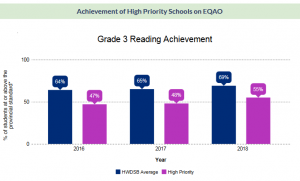
Student Achievement Focus Yields Results at High Priority Schools
 HWDSB’s significant investments are improving reading and math at high priority elementary schools.
HWDSB’s significant investments are improving reading and math at high priority elementary schools.
The High Priority School Strategy launched in 2017-18 identified 20 elementary schools as high priority based on previous high/moderate needs, low student achievement and data from the census, the Early Development Instrument and superintendent visits.
“We have dedicated significant resources to our High Priority Schools and this has allowed us to focus on school leadership, resources, learning more about school conditions, and engaging community partners,” Director of Education Manny Figueiredo said as the Program Committee received the Student Learning and Achievement Report.
“This investment has led to initial progress in the right direction for our High Priority Schools, which we are eager to see continue.”
Comparing 2018 to 2017, HWDSB saw progress:
- The percentage of Grade 1 students in High Priority Schools earning a B in reading rose eight per cent.
- Grade 3 reading EQAO results saw the number of HWDSB students reading at provincial standard rise four percent, while it rose seven per cent at High Priority Schools.
- High Priority Schools increased their percentage of students reaching provincial standard on EQAO Grade 3 Math by four per cent and maintained their achievement in Grade 6 math.
For 2018-19, HWDSB will continue to focus on reading by providing educators with professional learning on comprehensive literacy instruction, assessment and interventions.
HWDSB will also implement a dedicated daily focus on reading, and refine the measures used to watch the progress students make towards becoming effective readers by the end of Grade 1.
Building on the Student Information Strategy developed in 2017-18, 2018-19 will feature the further implementation of digital tools for monitoring student progress towards graduation. As well, SOSAs will continue to track credit attainment, community hours, and OSSLT status for year four and five secondary students. The vision is to work backwards from the current graduation requirements (30 credits, OSSLT, and 40 community hours) to identify relevant data, the threshold of risk for the data, and the appropriate interventions for support.
As the High Priority Schools Strategy continues, these schools will receive a full-time Reading Specialist and Early Childhood Educators assigned to each Kindergarten classroom, which is capped at 26 students.
“Early reading is the foundation of success in all subject areas,” Figueiredo said. “This is why we deployed 48 Reading Specialists to work directly with students and staff in Kindergarten and Grade 1 classrooms. After one year of this strategy, we are starting to see some successes that we can continue to build on.”
Other facets of the High Priority Schools Strategy involve assigning administrators to the schools based on the best fit; extra resources including reading specialists, student success teachers, math facilitators and elementary program consultants; regular meetings of diverse staff groups to identify successful practices; and the nurturing of community partnerships.
Updated on Wednesday, November 21, 2018.



